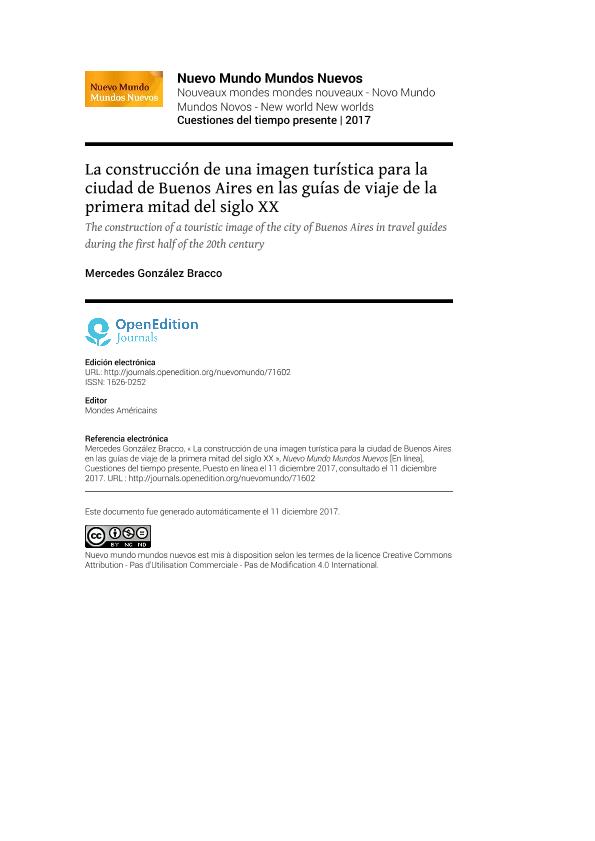Artículo
Hoy en día, la industria turística nos ofrece destinos de viaje a través de ciertas imágenes repetidas para ser fijadas como icónicas. Al pensar en Buenos Aires, el obelisco, la Plaza de Mayo y el Palacio del Congreso son algunos de estos lugares propuestos como representaciones de la ciudad. Ahora bien, ¿fueron siempre estas imágenes? ¿cuáles fueron los criterios de selección? ¿a quiénes estaban destinadas? ¿qué decían (y aún dicen) de la ciudad? Partimos de la hipótesis de que existe una “imagen turística” de Buenos Aires que acompañó la construcción del Estado-nación, pero que también formó parte del desarrollo de nuevas tecnologías y la creciente mercantilización del ocio en un contexto de surgimiento de la sociedad de masas. En atención a la importancia de las guías de viaje en dicho proceso, analizamos una serie relatos y fotografías que, circulando en materiales de lectura bajo diversas denominaciones (“manual del viajero”, “guía del viajero”, “guía turística”) fueron elaborados con la intención de mostrar la ciudad a los posibles visitantes. Allí observamos qué narraciones e imágenes fueron seleccionadas y cómo fueron organizadas, atendiendo a la necesidad de mostrar una ciudad moderna y cosmopolita. Nowadays, the tourist industry offers us travel destinations through certain repeated images to be fixed as iconic. When thinking about Buenos Aires, the obelisk, the Plaza de Mayo and the Palace of Congress are some of these places proposed as city representations. So, at what point did these images emerge? What were the selection criteria? To whom were they meant for? What did they say (and still say) about the city? We start from the hypothesis that there is a "touristic image" of Buenos Aires that accompanied the construction of the nation-state, but also was part of the development of new technologies and the increasing commodification of leisure in a context of the emergence of mass society. In view of the importance of the travel guides in this process, we analyze a series of photographs that, circulating in reading materials under various denominations ("traveler's manual", "traveler's guide", "guidebook”) intended to show the city to potential visitors. There we observe which tales and images were selected and how they were organised, taking into account the need to show a modern and cosmopolitan city.
La construcción de una imagen turística para la ciudad de Buenos Aires en las guías de viaje de la primera mitad del siglo XX
Título:
The construction of a touristic image of the city of Buenos Aires in travel guides
during the first half of the 20th century
Fecha de publicación:
12/2017
Editorial:
École des hautes études en sciences sociales
Revista:
Nuevo mundo mundos nuevos
ISSN:
1626-0252
Idioma:
Español
Tipo de recurso:
Artículo publicado
Clasificación temática:
Resumen
Palabras clave:
Historia Urbana
,
Turismo
,
Buenos Aires
,
Imagen Turistica
Archivos asociados
Licencia
Identificadores
Colecciones
Articulos(SEDE CENTRAL)
Articulos de SEDE CENTRAL
Articulos de SEDE CENTRAL
Citación
González Bracco, María de las Mercedes; La construcción de una imagen turística para la ciudad de Buenos Aires en las guías de viaje de la primera mitad del siglo XX; École des hautes études en sciences sociales; Nuevo mundo mundos nuevos; 2017; 12-2017; 1-16
Compartir
Altmétricas




